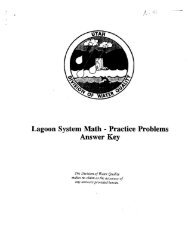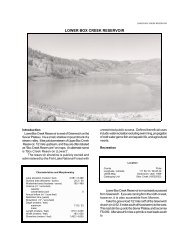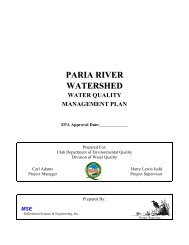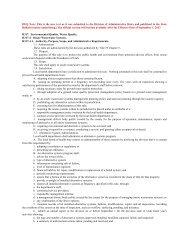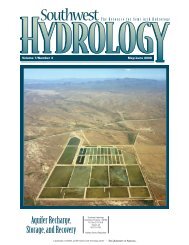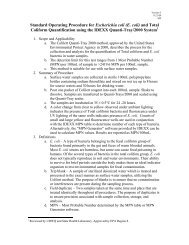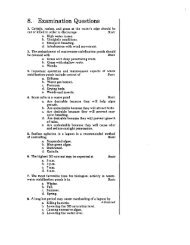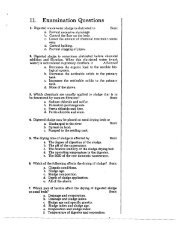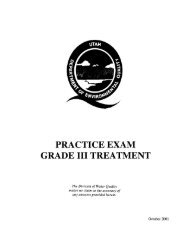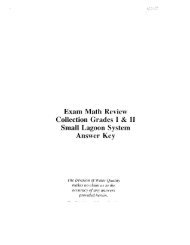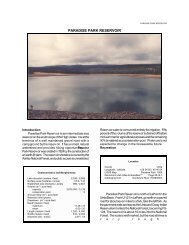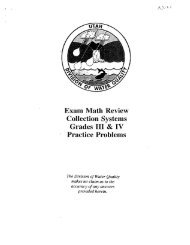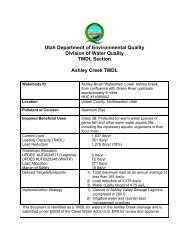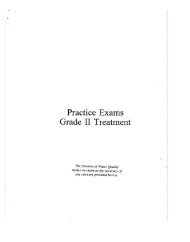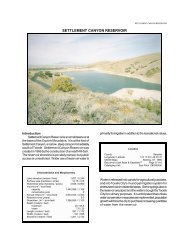Silver Creek - Division of Water Quality - Utah.gov
Silver Creek - Division of Water Quality - Utah.gov
Silver Creek - Division of Water Quality - Utah.gov
Create successful ePaper yourself
Turn your PDF publications into a flip-book with our unique Google optimized e-Paper software.
<strong>Silver</strong> <strong>Creek</strong> <strong>Water</strong>shed TMDL Final Report<br />
6.0 SOURCES<br />
6.1 Known Sources <strong>of</strong> Contaminants<br />
Existing data were adequate for determining contaminant loading between data sampling points<br />
along <strong>Silver</strong> <strong>Creek</strong> (contaminant loading is presented in pounds per mile <strong>of</strong> stream rather than by<br />
responsible parties in Section 4.3). However, sufficient data are unavailable to adequately<br />
allocate contribution <strong>of</strong> contaminants by specific site. Further, there are numerous smaller<br />
source areas not specifically listed in Table 11 that undoubtedly contribute zinc and cadmium to<br />
the creek. Table 11 identifies the major land owners within the various major source areas <strong>of</strong><br />
<strong>Silver</strong> <strong>Creek</strong>. Figure 22 identifies the major contaminated areas, which are referred to as source<br />
areas.<br />
Table 11 : List <strong>of</strong> Known Sources<br />
Description<br />
Owner<br />
Upper <strong>Water</strong>shed Sources<br />
United Park City Mines<br />
Prospector Square groundwater drain Park City Municipal Corporation<br />
<strong>Silver</strong> Maple Claims<br />
BLM<br />
Flood Plain Tailings<br />
United Park City Mines<br />
Richardson Flats<br />
United Park City Mines<br />
Meadow Area<br />
Various Private Land Owners<br />
All indications suggest that the metals <strong>of</strong> concern in this watershed are from historical mining<br />
activities in the Park City area. Most <strong>of</strong> the mining activity occurred within the upper watershed,<br />
primarily within Empire Canyon. Tailings from these mines were stored onsite or removed to<br />
another location, typically downstream.<br />
Several downstream locations were used to further reduce and process the discarded mine<br />
tailings in an attempt to remove additional metals. The lower reaches <strong>of</strong> the stream have<br />
significant amounts <strong>of</strong> mine tailings that are easily detected by the casual observer. These<br />
locations include, but are not limited to, <strong>Silver</strong> Maple Claims, Richardson Flats, Flood Plain<br />
Tailings and the Meadow area.<br />
Contamination mechanisms vary from site to site but are generally attributed to surface or<br />
ground water contact with mining related metals contamination. The upper watershed, due to its<br />
overall steepness, is characterized by relatively high flow velocities and concentrations that have<br />
a tendency to carry sediments and other materials to receiving waters, in this case <strong>Silver</strong> <strong>Creek</strong><br />
and its tributaries. Contaminated areas that are exposed or saturated by shallow ground water<br />
will contribute to metals loading in the stream channels.<br />
The Upper watershed source area includes discharges from two mining tunnels, the Judge and<br />
Spiro Tunnels. The majority <strong>of</strong> these flows are captured for use in the Park City Municipal<br />
drinking water system. Zinc concentrations for these tunnels have been reported at 0.81 mg/l for<br />
the Judge and 0.22 mg/l for the Spiro Tunnel (NPDES Form 2A October 2002). Estimated zinc<br />
loads from the respective tunnel flows that actually enter <strong>Silver</strong> <strong>Creek</strong> are less than 100 lbs. per<br />
year from the Judge Tunnel and 300 lbs. per year from the Spiro Tunnel. These values are not<br />
Page 35



